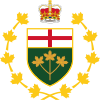Lieutenant Governor of Ontario
| Lieutenant Governor of Ontario | |
|---|---|
|
Shield of the Lieutenant Governor | |
| Viceroy | |
| Style | Her Honour the Honourable |
| Appointer | Governor General of Canada |
| Term length | At the Governor General's pleasure |
| Formation | 1 July 1867 |
| First holder | Henry William Stisted |
| Website | www.LGOntario.ca |

The Lieutenant Governor of Ontario (/lɛfˈtɛnənt/, in French: Lieutenant-gouverneur (if male) or Lieutenante-gouverneure (if female) de l'Ontario) is the viceregal representative in Ontario of the Canadian monarch, Queen Elizabeth II, who operates distinctly within the province but is also shared equally with the ten other jurisdictions of Canada, as well as the other Commonwealth realms and any subdivisions thereof, and resides predominantly in her oldest realm, the United Kingdom. The Lieutenant Governor of Ontario is appointed in the same manner as the other provincial viceroys in Canada and is similarly tasked with carrying out most of the monarch's constitutional and ceremonial duties.[1] The current Lieutenant Governor of Ontario is Elizabeth Dowdeswell.
Role and presence
The Lieutenant Governor of Ontario is vested with a number of governmental duties and is also expected to undertake various ceremonial roles. For instance, the lieutenant governor acts as patron of certain Ontario institutions, such as the Royal Ontario Museum. Also, The viceroy, him- or herself a member and Chancellor of the order,[2] will induct deserving individuals into the Order of Ontario, and upon installation automatically becomes a Knight or Dame of Justice and the Vice-Prior in Ontario of the Most Venerable Order of the Hospital of Saint John of Jerusalem.[3] The viceroy further presents the Royal Canadian Humane Association medal,[4] the Lincoln M. Alexander Award, the Ontario Volunteer Service Award, the Outstanding Achievement Award for Voluntarism in Ontario, the Ontario Medal for Young Volunteers, and numerous other provincial honours and decorations, as well as various awards that are named for and presented by the lieutenant governor; these are generally created in partnership with another government or charitable organization and linked specifically to their cause.[5] These honours are presented at official ceremonies, which count amongst hundreds of other engagements the lieutenant governor partakes in each year, either as host or guest of honour; in 2006, the Lieutenant Governor of Ontario undertook 579 engagements and 614 in 2007.[6]

.svg.png)
At these events, the lieutenant governor's presence is marked by the post's official flag, consisting of a blue field bearing the escutcheon of the Arms of her Majesty in Right of Ontario surmounted by a crown and surrounded by ten gold maple leaves, symbolizing the ten provinces of Canada. Within Ontario, the lieutenant governor also follows only the sovereign in the province's order of precedence, preceding even other members of the Canadian Royal Family and the Queen's federal representative.[7]
History
The office of Lieutenant Governor of Ontario came into being in 1867, upon the creation of Ontario at Confederation,[8] and evolved from the earlier position of Lieutenant Governor of Canada West. Since that date, 28 lieutenant governors have served the province, amongst whom were notable firsts, such as Pauline Mills McGibbon—the first female lieutenant governor of the province—and Lincoln Alexander—the first lieutenant governor of West Indian ancestry. The shortest mandate by a Lieutenant Governor of Ontario was Henry William Stisted, from 1 July 1867 to 14 July 1868, while the longest was Albert Edward Matthews, from November 1937 to December 1946.[9]
With the election in 1937 of the Liberal Party to a majority in the Legislative Assembly, the Office of the Lieutenant Governor in Ontario was targeted for spending cutbacks. Government House was closed and the viceroy given a suite at the Legislative Building as a replacement. The post then remained relatively low-key until 1985, when the personal discretion of Lieutenant Governor John Black Aird was required in the exercise of the royal prerogative: After Frank Miller that year lost the confidence of the Legislative Assembly, the opposing Liberal Party managed to negotiate a deal with both the New Democratic Party (NDP) and independent members of the assembly,[10] wherein a prospective Liberal government would receive for two years the confidence of the others in exchange for certain policy reforms. Aird thus called upon David Peterson to serve as premier, rather than dissolve the legislature only 55 days after the last election.[11][12]
See also
References
- ↑ Victoria (29 March 1867). "Constitution Act, 1867". V.58. Westminster: Queen's Printer. Retrieved 15 January 2009.
- ↑ Ministry of Citizenship and Immigration, Honours and Awards > Order of Ontario, Queen's Printer for Ontario, retrieved 4 July 2009
- ↑ "The Order of St. John in Canada". St. John Ambulance Canada. Retrieved 2 June 2009.
- ↑ Robertson, Ian (26 May 2007). "Boy's ultimate sacrifice". Toronto Sun. Retrieved 27 May 2007.
- ↑ Office of the Lieutenant Governor of Ontario. "Awards". Queen's Printer for Ontario. Retrieved 4 July 2009.
- ↑ Berezovsky, Eugene (2009). Staff of Canadian Monarchist News, ed. "$1.52 per Canadian: The Cost of Canada's Constitutional Monarchy" (PDF) (4 ed.). Toronto: Monarchist League of Canada. p. 3. Retrieved 15 May 2009.
- ↑ "Symbols of Office". Queen's Printer for Ontario. 11 May 2014. Retrieved 2015-02-17.
- ↑ Victoria 1867, V.63
- ↑ Office of the Lieutenant Governor of Ontario. "Quick Facts". Queen's Printer for Canada. Retrieved 5 July 2009.
- ↑ Jackson, Michael D. (2007). "The Crown in Today's Federal State" (PDF). Canadian Monarchist News (Toronto: Monarchist League of Canada). Autumn-Winter 2007 (27): 11. Retrieved 5 July 2009.
- ↑ Rae, Bob. "The Accord 25 Years Later". Liberal Party of Canada. Retrieved 27 October 2012.
- ↑ Donovan, Davis S. (27 May 2009), The Governor General and Lieutenant Governors: Canada's Misunderstood Viceroys (PDF), Canadian Political Science Association, p. 9, retrieved 30 October 2012
External links
| ||||||||||||||
| ||||||||||||||||||||||||||||||||||||||||||||||
| ||||||||||||||||||||||||||||

